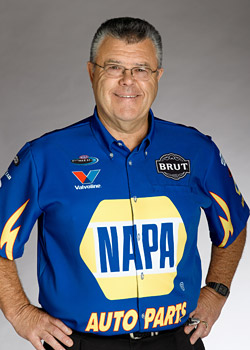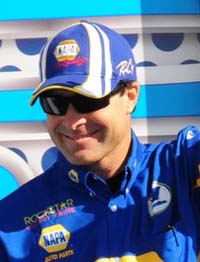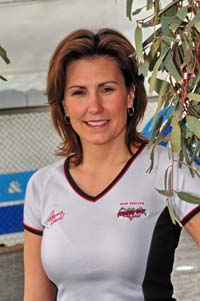FUNNY CAR WEIGHT DEBATE
 Oh, what Ed “Ace”
McCulloch would give for access to one of those miracle weight-loss
products. You know the ones. Their commercials proliferate late-night
television: “Lose 60 pounds in 60 Days,
the
Oh, what Ed “Ace”
McCulloch would give for access to one of those miracle weight-loss
products. You know the ones. Their commercials proliferate late-night
television: “Lose 60 pounds in 60 Days,
the
But alas, none is
applicable for McCulloch because the extra baggage isn’t around his hips. It belongs to the NAPA Auto Parts Dodge
Charger that he tunes and Ron Capps drives.
New Funny Car rules
legislated this year piled on 100 extra pounds raising the minimum weight to
2,555 pounds, a number the former Funny Car and Top Fuel driver finds
overwhelming. His gripe, he points out,
isn’t with the safety aspect.
“I’m all for safety,” said
McCulloch. “I’m all for making these
cars safer. If we have to have a stronger car – which we do – I’m all for what
we have to do.”
McCulloch, a drag racing veteran who began his successful driving career at the wheel of a late 1960s push-started, front-motored Top Fuel dragster like everyone else drove at the time, does have a few suggestions.
 Oh, what Ed “Ace”
McCulloch would give for access to one of those miracle weight-loss
products. You know the ones. Their commercials proliferate late-night
television: “Lose 60 pounds in 60 Days,
the
Oh, what Ed “Ace”
McCulloch would give for access to one of those miracle weight-loss
products. You know the ones. Their commercials proliferate late-night
television: “Lose 60 pounds in 60 Days,
the
But alas, none is
applicable for McCulloch because the extra baggage isn’t around his hips. It belongs to the NAPA Auto Parts Dodge
Charger that he tunes and Ron Capps drives.
New Funny Car rules
legislated this year piled on 100 extra pounds raising the minimum weight to
2,555 pounds, a number the former Funny Car and Top Fuel driver finds
overwhelming. His gripe, he points out,
isn’t with the safety aspect.
“I’m all for safety,” said
McCulloch. “I’m all for making these
cars safer. If we have to have a stronger car – which we do – I’m all for what
we have to do.”
McCulloch, a drag racing veteran who began his successful driving career at the wheel of a late 1960s push-started, front-motored Top Fuel dragster like everyone else drove at the time, does have a few suggestions.
A lot of drivers walking around in preseason testing at Phoenix were asking if anybody else was having a little bit harder time slowing the cars down. It’s very noticeable to me. I’ve had to go from pulling one parachute at a lot of tracks, especially Phoenix, to always pulling two chutes and getting on the brakes hard. - Ron Capps
“I think there are two
options for the Funny Car chassis, and the heavier of the two options would be
to add 30 pounds. With the rest of the
safety things that they’ve implemented, we already are looking at about 40
pounds of increased weight. If they’d put 50 or 60 pounds on us, I would have
been okay with that. But to put [a total
of] 100 pounds on us?”
Moreover, McCulloch says
his car made weight last year, thanks to the fact Capps is one of the lightest
drivers in the class. “We are being penalized big time. I have 110 pounds of ballast on our car
(including the 10 to make sure the car isn’t light). Does it make a safer race
car? Absolutely not.”
What it does do, however,
is require a different tune-up to move the bulked-up racecar off the starting
line with the same gusto it had a year ago. And, in McCulloch’s situation, he
needed to find the right places to hang the weight. Other tuners, meanwhile, who already were
dealing with an overweight car – 40 to 50 pounds in some cases – found that
amount to be more manageable.
 “Ace has been trying to
figure out how to get the car going quicker earlier in the run,” Capps
said. “The extra weight we have bolted
on it now makes it a completely different car.
It’s much heavier. We’ve had our work cut out for us.”
“Ace has been trying to
figure out how to get the car going quicker earlier in the run,” Capps
said. “The extra weight we have bolted
on it now makes it a completely different car.
It’s much heavier. We’ve had our work cut out for us.”
McCulloch did regroup at
last Monday’s
While many crew chiefs
fought the battle of the bulge, drivers, meanwhile, were facing a totally
different dilemma at the other end of the track – getting their cars stopped
before reaching the sand box.
“I noticed how hard it was
to slow the cars down right away in testing,” Capps said. “We have that extra
100 pounds of ballast and there were a lot of teams that didn’t have to add any
weight.
“A lot of drivers walking
around in preseason testing at
“As we saw in
“Another thing you have to
remember is we are running speeds less than we were last year . . . 318-319
(mph) at Phoenix, and I’m having to get on the brakes with both chutes out just
to make a safe turn at the end. I’m
going to talk with Bill Simpson at Impact about it. He has some ideas about improving the
parachutes. The weight has definitely
affected not only the way you drive the car, but even more so slowing them
down.”
Melanie Troxel, new driver
of Mike Ashley’s Funny Car this year, says Brian Corradi and Mark Oswald,
co-crew chiefs on the Pro Care RX Dodge Charger, have had to overcome not only
the extra 100 pounds, but, “we had to add another 30-to-40 pounds in the weight
difference between Mike and I,” she said.
“It made it hard on us just to find places to hang that much weight on
the car.
“And then to get that much
extra weight moving on the track, I think, is something a lot of teams have struggled
with. That’s one of the things we’ve been working on.”

“At
Her husband, Tommy Johnson
Jr., a veteran Funny Car chauffeur now driving Kenny Bernstein’s Monster Energy
Drink Dodge, was able to provide more insight.
“Obviously, I think the
weight has changed the way the car performs and reacts a little bit,” he
said. “They definitely don’t leave the
line as hard as they used to. It’s hard
to get that extra weight going.
And once you do get it
going, it seems harder to slow it down.
“I’d say, on average, the
cars are 50 pounds heavier because most everybody was a little over (the
limit). But just that extra little big
of weight has really affected the way they stop. I’ve been so many more guys than normal go
off the track. I haven’t had any
problems but I have noticed I’ve had to use the brakes more in the shutdown
area than I used to. It definitely changed it. I always use both chutes but
I’ve had to get on the brake a little harder to stop.
“I really didn’t think I’d
notice a difference but as time’s gone on and I’m making more full runs and
better runs, the faster you go it seems it is a little harder to stop.”
At the starting line,
however, “the cars don’t leave as well, either,” Johnson continued. “We’ve
really had to work to get the car to leave the starting line.
“I believe the reason Tim
Wilkerson (No. 1 qualifier at
“Our car is a lot heavier
than it’s ever been so now we are trying to figure out how to make this heavy
weight go and Wilkerson has already figured it out. I know Jimmy (Walsh, team crew chief) had to
change some things and we worked at it quite a while to get the 60-foot times
better . . . and they still aren’t where they were in the past. But they are
back to where they are competitive.”
A new wrinkle awaits
Johnson and the Monster team. They have
a new Brad Hadman chassis they plan to test soon.
“Now we have to figure out
what to do with the new one,” added Johnson.
“This is a different car -- bigger tubing and we will have to change a
lot of things again. We are going to do
a lot of testing, I think, before we actually switch to the Hadman
chassis. We plan to test it before
Johnson, who joined
Bernstein’s team in the off-season, was fitted for the Murf McKinney cars and
he spent three hours last week getting fitted for his new “office chair.”
“We’ll probably run the
Elsewhere, the John Force
Racing team – the 14-time champion and 125-race winner, his daughter Ashley,
Robert Height and Mike Neff – has not experienced problems slowing their cars,
said Dave Densmore, the team’s award-winning publicist.
“My guys haven't had any
trouble stopping except when they don't pull the chutes. Pulling the chutes, apparently, is
important. Force just missed them on two
test runs at
These perplexing problems
– much like the 85-and 90-percent nitromethane edicts of the past – will soon
prove to be mere distractions as the team crew chiefs work diligently to eradicate
them. There are, after all, 22 races to
go – plenty of time for permanent fixes.




































